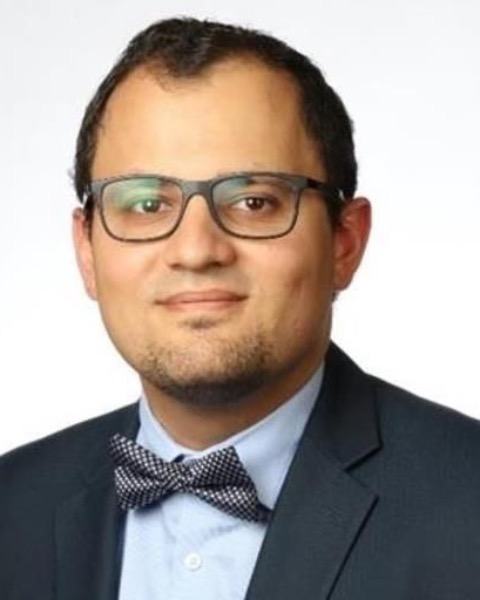Oral Abstract Session
OA-42: Second Primary Malignancies after Tandem Autologous Hematopoietic Stem Cell Transplantation for patients with Multiple Myeloma Treated on Earlier Total Therapy Protocols
Thursday, September 28, 2023
5:51 PM - 6:03 PM EEST
Location: Skalkotas

Samer Al Hadidi, MD,MS,FACP
Assistant Professor
the University of Arkansas for Medical Sciences
Little Rock, Arkansas, United States
Speaker(s)
Introduction: The use of high-dose chemotherapy followed by tandem autologous hematopoietic stem cell transplantation (auto-HSCT) has resulted in improved outcomes for patients with multiple myeloma (MM) While auto-HSCT is recognized as a standard of care for newly diagnosed transplant-eligible MM patients due to the improved long-term disease control and survival it provides, the exposure to high-dose chemotherapy is associated with an increased risk of second primary malignancies (SPMs), with a subset of SPMs categorized as second hematologic malignancies (SHM). Our study aims to provide the incidence of SPMs and SHMs on patients treated on TT I-IIIB based on long-term follow up
Methods: Patients enrolled on total therapy I (NCT00580372), II (NCT00083551), IIIA (NCT00081939) and IIIB (NCT00572169) between 1989-2008 were included. Patients were treated at the University of Arkansas for Medical Sciences with combination-based chemotherapy, tandem auto-HSCT and maintenance therapy, and followed for development of SPMs and SHMs.
Results: Among 1379 patients with newly diagnosed MM enrolled on four TT trials with a median follow up range of 15-25 years. SPMs (including SHMs and excluding non-melanoma skin cancer) occurred in 11.8% of patients of which 64.4% of SPMs were solid tumors (most common were prostate cancer (n=22), colorectal cancer (n=20), breast cancer (n=15), lung cancer (n=11), and bladder cancer (n=7). A total of 4.2% (n=58) of patients developed a SHM. SHMs include acute lymphoblastic leukemia (ALL) (n=4), acute myeloid leukemia (2.4%, n=33), myelodysplastic syndrome (0.7%, n=9), B-cell lymphoma (n=10), chronic myelomonocytic leukemia (n=1) and unspecified leukemia (n=1). Median time to first SHM in patients treated on TT I, TT II (+thalidomide), TT II (-thalidomide), TT IIIA, TTIIIB were 10.7, 7.67, 10.3, 5.56, and 6.23 years, respectively. No statistical difference between risk of SHMs and enrollment on specific clinical trial, was observed. However, all four ALL cases occurred in patients who were exposed to an immunomodulatory drug. No difference in SPMs were observed in patients treated on TT IIIB when compared to TT IIIA.
Conclusions: The occurrence of SHMs in patients who were treated with tandem-autologous hematopoietic stem cell transplantation on earlier TT protocols and followed up for a median of more than 15 years was 4.2%. The risk of AML and/or MDS was 3.1%. Our long-term follow up indicates that the risk of developing SHMs is relatively low. With the improvement in long-term outcomes of MM patients it is important to consider the risk of developing various cancers and consider appropriate
Methods: Patients enrolled on total therapy I (NCT00580372), II (NCT00083551), IIIA (NCT00081939) and IIIB (NCT00572169) between 1989-2008 were included. Patients were treated at the University of Arkansas for Medical Sciences with combination-based chemotherapy, tandem auto-HSCT and maintenance therapy, and followed for development of SPMs and SHMs.
Results: Among 1379 patients with newly diagnosed MM enrolled on four TT trials with a median follow up range of 15-25 years. SPMs (including SHMs and excluding non-melanoma skin cancer) occurred in 11.8% of patients of which 64.4% of SPMs were solid tumors (most common were prostate cancer (n=22), colorectal cancer (n=20), breast cancer (n=15), lung cancer (n=11), and bladder cancer (n=7). A total of 4.2% (n=58) of patients developed a SHM. SHMs include acute lymphoblastic leukemia (ALL) (n=4), acute myeloid leukemia (2.4%, n=33), myelodysplastic syndrome (0.7%, n=9), B-cell lymphoma (n=10), chronic myelomonocytic leukemia (n=1) and unspecified leukemia (n=1). Median time to first SHM in patients treated on TT I, TT II (+thalidomide), TT II (-thalidomide), TT IIIA, TTIIIB were 10.7, 7.67, 10.3, 5.56, and 6.23 years, respectively. No statistical difference between risk of SHMs and enrollment on specific clinical trial, was observed. However, all four ALL cases occurred in patients who were exposed to an immunomodulatory drug. No difference in SPMs were observed in patients treated on TT IIIB when compared to TT IIIA.
Conclusions: The occurrence of SHMs in patients who were treated with tandem-autologous hematopoietic stem cell transplantation on earlier TT protocols and followed up for a median of more than 15 years was 4.2%. The risk of AML and/or MDS was 3.1%. Our long-term follow up indicates that the risk of developing SHMs is relatively low. With the improvement in long-term outcomes of MM patients it is important to consider the risk of developing various cancers and consider appropriate
